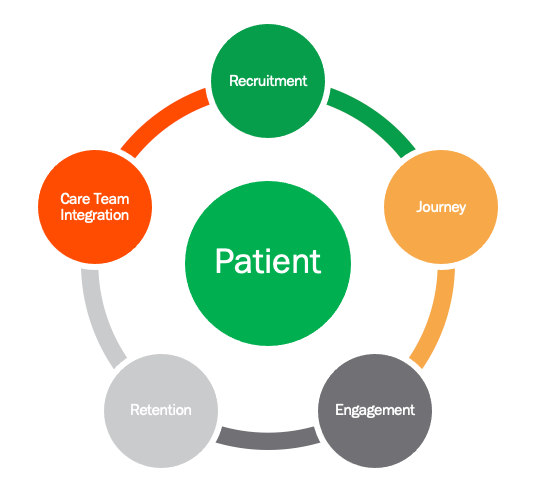Optimizing Patient Recruitment and Engagement Strategies
Five strategies to reduce risk and achieve deadlines.


How long is too long? For decades, clinical trial sponsors and CROs have struggled with patient recruitment challenges as the number one reason for study delays and associated budget increases. Year after year, at conference after conference, industry leaders have debated how best to address this familiar challenge. The COVID-19 pandemic has made the situation even worse, with a lingering effect on studies focused on other diseases.1 In the early part of the pandemic, from February to May 2020, the number of trials launched in the United States amounted to only 57% of the number expected without the pandemic.2
On a positive note, our industry is making it easier for patients to participate in clinical trials in many ways. However, it is not a ‘one-size-fits-all’ approach and at times makes it more challenging for patients and sites as we introduce new technologies. Remote activities have changed the way trial Sponsors and CROs work with investigative site staff, and it often requires more of a burden on the sites to upload documents, rearrange their processes and address new budget issues from incorporating this approach.
The real issue remains: How do we efficiently reach a large sample of potential patients? As an industry, we have the obligation to complete trials in a timely manner. It took a pandemic to move us to a new form of patient interaction that allows participation without travel to the investigative site. With change already happening, it should be easier to innovate at a faster pace. Strategies need to incorporate a multi-faceted and customized solution for the best predictability and greatest success. It all starts with fully understanding the patient.
As trial design and management strategies are developed, five key strategies are recommended to deploy a thoughtful and proactive approach that meets study timelines and goals.
Figure 1. Optimizing interactions with clinical trial participants

Strategy 1: Trial design and location
Once a clinical trial is designed, many logistical planning efforts must follow to successfully implement and manage the trial. One key factor is how and where the investigational product will be shipped once ready—to the site or directly to the patient. Once engaged, the patient experience is key to their willingness to participate over the required timeframe. Factors such as in-person office visit frequency and the requirements of each visit will affect continued participation. Input from care teams and directly with patients is critical to understanding the journey and perspectives affecting protocol design—elements that may change sharply between countries based on varying healthcare options, cultural norms, therapeutic indications, and other geographic considerations. These factors can shape the trial design and willingness of both sites and patients to participate in certain activities within a protocol. Trial design and location is the most important early planning activity to ensure success.
Strategy 2: Global feasibility
The most successful companies invest significant time into thoroughly understanding the feasibility of the trial and its associated costs and timelines. This exploration should occur very early and is more than feasibility at the time of RFP sent to a provider. The best results are produced when feasibility activity occurs both at the time of trial design and after the protocol is written. The most appropriate type of feasibility will include analyzing the therapeutic indication, epidemiology, geographical standard-of-care differences, site feedback, patient feedback, utilization of historic and current data, as well as operational considerations with recommended risk mitigation strategies. Specific items detailed in the protocol may change how a site or patient will feel about participation. Investigators may have perspectives on patient needs that differ from the patients’ own perspectives. Reaching out directly to the patient population requires a change of mindset for most trial sponsors, which has traditionally relied primarily on Principal Investigators to provide insights on patients. A comprehensive feasibility exercise helps develop a strategy that is accurate in predicting costs and timelines and identifies key risks to consider in the study plan.
Strategy 3: Reducing risk
With any study comes risk, but some involve more risk than others. Each study should have its own risk management plan, accounting for patient enrollment and retention risks. Even with the best feasibility and alignment with management, everything may not go according to plan. Defining the key leading or risk indicators that will continually measure success is important, as well as setting specific timepoints to measure those indicators. In addition, it is important to have a ‘plan B’ in place, ready to implement if needed. The plan B decision criteria should be defined up front and align with all stakeholders to best manage and overcome risks.
Strategy 4: Alignment and managing expectations
Alignment is needed among the study team (including the trial sponsor, CRO, other providers and sites) on the plan, timelines, and costs associated with the study; however, this is not always easy to accomplish. Once aligned, each team member should communicate the plan with their respective management teams—including the risks, risk management plans, and costs associated with those plans. Implementing these key strategies helps ensure that there are no surprises to any team members, and thus no need for unexpected requests for more time and money. Keep in mind, robust feasibility assessments are a starting point and will evolve with a study; expectations should be clear, fluid, flexible and continually communicated.
Strategy 5: Recruiting, engaging, and retaining patients
Recruiting, engaging, and retaining patients should each have a separate strategy, and these should be integrated with one another to ensure a consistent patient experience through to study completion. This optimizes the chance of retention and minimizes the risk to study timelines.
Unfortunately, there is no one-size-fits-all solution to tackling the challenges brought on by patient recruitment. New data platforms and EMR technologies are slowly providing information about doctors that see specific patient populations. At best, these technologies and data systems are providing small pictures into the patient population or Principal Investigator experiences. Each study has its own unique patient population and study challenges. Some studies may lend themselves to incorporating DCT components and technologies while others may not. If the Sponsor/CRO has listened to the voice of the patient, understands their journey and has designed the study accordingly, followed by performing global feasibility and risk planning, then study management projections and success should follow.
The above steps, when done thoroughly and early, will demonstrate success in today’s environment. The challenge for our industry remains the same: How do we make sure more potential patients know about opportunities for clinical trial participation? We know that many doctors do not present clinical trial opportunities to their patients. Referrals of patients have always been a challenge as doctors do not like to lose patient revenue to other physicians. Trial participation isn’t something that enters into everyday life in the way other information is presented to consumers and potential trial patients. There are online and traditional recruitment approaches, thought leader involvement in rare diseases and other recruitment activities that make a difference. However, if we only integrate these strategies into mitigation plans and not proactively into every single trial plan, history will keep repeating itself and recruitment will remain the number one hurdle our industry faces.
How will we innovate to the next level? We have made great progress in our ability to engage patients, but how will we connect with more patients faster? After all, we are here to benefit the patient community and to provide treatments, support and hope to them. Who are the innovators out there? Are we all up for the assignment? If so, let’s get those together who get it and make a difference!
Caroline Redeker, Senior Vice President of Corporate Development at Advanced Clinical, and Donna Hanson, Senior Director of Strategy and Optimization at Advanced Clinical
References
- Ledford H. The COVID pandemic's lingering impact on clinical trials. Nature. 2021 Jul;595(7867):341-342. doi: 10.1038/d41586-021-01569-9. PMID: 34183846; https://media.nature.com/original/magazine-assets/d41586-021-01569-9/d41586-021-01569-9.pdf
- Unger, J.M., Xiao, H. The COVID-19 pandemic and new clinical trial activations. Trials 22, 260 (2021). https://doi.org/10.1186/s13063-021-05219-3; https://trialsjournal.biomedcentral.com/articles/10.1186/s13063-021-05219-3
Reaching Diverse Patient Populations With Personalized Treatment Methods
January 20th 2025Daejin Abidoye, head of solid tumors, oncology development, AbbVie, discusses a number of topics around diversity in clinical research including industry’s greatest challenges in reaching diverse patient populations, personalized treatment methods, recruitment strategies, and more.